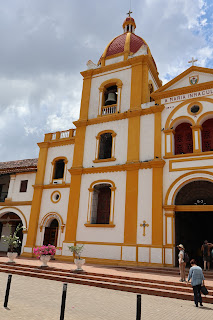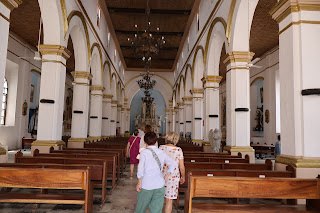Nestled in the heart of Santa Cruz de Mompox, Colombia, the
Oratorio Inmaculada Concepción is an example of colonial architecture
and religious devotion. Originally constructed in 1541 by Pedro de Heredia
using adobe and thatch, the church underwent significant renovations over the
centuries, culminating in a complete reconstruction in 1839. Today, it stands
as a serene and elegant temple dedicated to the Virgin Mary under the title of
the Immaculate Conception, reflecting the town’s deep-rooted Catholic
heritage.
The oratory’s facade is a harmonious blend of symmetry and artistry, featuring
graceful arches and a dome that crowns the structure with quiet majesty.
Inside, visitors are greeted by a warm, contemplative atmosphere enhanced by
soft natural light filtering through its windows. The main altar is adorned
with an image of the Immaculate Conception, and a large statue of
Jesús Nazareno adds to the spiritual ambiance, especially during Holy
Week, when the church plays a central role in Mompox’s renowned religious
processions.
Beyond its architectural beauty, the
Oratorio Inmaculada Concepción serves as a cultural touchstone for the
local community. It’s not just a place of worship but a living monument to the
town’s colonial past and spiritual resilience. Visitors often describe the
experience as magical—an invitation to pause, reflect, and connect with the
layered history of this UNESCO World Heritage town.
Whether you’re drawn by faith, history, or aesthetics, the oratory offers a
tranquil escape from the bustle of modern life. Early morning or late
afternoon visits are especially recommended for their peaceful ambiance and
golden light, perfect for quiet contemplation or photography. It’s one of
those rare places where time seems to slow down, allowing you to truly absorb
the soul of Mompox.
|
Panorama of the facade of the Oratory of the Immaculate Conception
The façade of the Oratorio Inmaculada Concepción in Mompox
is a striking example of colonial symmetry and understated elegance.
Positioned prominently in the central square of Santa Cruz de Mompox, it
commands attention with its harmonious proportions and architectural
grace. The structure features a series of arched entrances that echo the
rhythm of the building’s interior, while a modest dome rises above,
adding vertical emphasis without overwhelming the overall design.
-
One of the most distinctive elements of the facade is its symmetrical
layout, which complements the surrounding colonial buildings and
enhances the visual cohesion of the plaza. The columns flanking the
entrance lend a sense of grandeur and permanence, while the soft
pastel tones of the exterior walls reflect the warm Caribbean light,
giving the oratory a welcoming and serene presence. Visitors often
remark on how the facade blends seamlessly with the town’s historic
aesthetic, making it a natural focal point for both locals and
tourists.
-
The facade also serves as a visual prelude to the spiritual experience
within. Its simplicity is intentional, allowing the architectural
details—such as the dome and arches—to speak quietly of reverence and
tradition. During religious festivals, especially Semana Santa,
the facade becomes a backdrop for processions and gatherings, further
embedding it into the cultural and spiritual life of Mompox.
-
Whether viewed in the golden light of morning or the soft glow of
evening, the facade of the
Oratorio Inmaculada Concepción offers a timeless snapshot of
Colombia’s colonial heritage. It’s not just a building—it’s a symbol
of continuity, faith, and the enduring beauty of thoughtful design.
|
|
Interior of the oratory
Stepping inside the
Oratorio Inmaculada Concepción in Mompox feels like entering a
sacred time capsule. The interior architecture is a graceful blend of
colonial elegance and spiritual reverence, marked by soaring arches and
imposing columns that lend the space a sense of grandeur. The symmetry
of the design, paired with the soft play of natural light filtering
through its windows, creates a tranquil and contemplative atmosphere
that invites visitors to pause and reflect.
-
At the heart of the oratory lies the main altar, which is dedicated to
the Virgin Mary under the title of the Immaculate Conception. This
altar is not only a focal point of devotion but also a visual
masterpiece, adorned with religious iconography that reflects
centuries of faith. A large and striking statue of
Jesús Nazareno stands nearby, deeply tied to Mompox’s Holy Week
traditions. During these celebrations, the statue becomes a central
figure in the town’s processions, adding layers of cultural and
spiritual significance to the space.
-
The interior also features a collection of religious artifacts and
artwork that narrate the town’s rich ecclesiastical history. From
intricately carved woodwork to delicate paintings, each element
contributes to the oratory’s aura of timelessness. The gentle
illumination from the windows casts subtle patterns on the stone
walls, enhancing the serene mood and making it an ideal setting for
quiet contemplation or prayer.
-
Visitors often describe the experience as magical—not just for the
beauty of the architecture, but for the palpable sense of peace that
permeates the space. Whether you're drawn by faith, history, or
aesthetics, the interior of the
Oratorio Inmaculada Concepción offers a deeply moving encounter
with Colombia’s colonial and spiritual heritage. It’s a place where
silence speaks volumes and every detail tells a story.
|
|
Our Lady of Mount Carmel
The cult of Our Lady of Mount
Carmel holds a deeply revered place in Colombian religious life,
blending centuries-old Catholic devotion with vibrant local traditions.
-
Celebrated annually on July 16th, the feast honors the Virgin Mary as
the spiritual protector of drivers, sailors, and military personnel.
In Colombia, she is affectionately known as
La Virgen del Carmen, and her image is often seen adorning
vehicles, altars, and homes. The devotion traces its roots to the
Carmelite Order and the brown scapular, a symbol of Mary’s promise of
protection and salvation to those who wear it faithfully. Over time,
this devotion has evolved into one of the most widespread and
culturally rich Marian cults in the country.
-
In the Caribbean and riverine regions of Colombia—especially in towns
like Santa Cruz de Mompox—the cult of Our Lady of Mount Carmel takes
on a particularly vivid expression. Mompox, with its colonial charm
and strong Catholic heritage, celebrates the Virgin with processions
that glide along the Magdalena River, where boats are adorned with
flowers and lights, carrying her image through the water. These
aquatic processions are not only acts of faith but also communal
spectacles that unite families, artisans, and clergy in a shared
spiritual experience. The river, central to Mompox’s identity, becomes
a sacred stage for honoring the Virgin’s protective role over
travelers and seafarers.
-
Beyond the religious rituals, the cult fosters social cohesion and
cultural identity. In Mompox, preparations for the feast begin weeks
in advance, involving music, traditional foods, and the crafting of
elaborate altars. The Virgin’s image is paraded through the streets,
accompanied by hymns, prayers, and blessings of vehicles—a nod to her
patronage over transportation. These celebrations serve as a living
testament to the town’s devotion, reinforcing generational ties and
offering a moment of collective reflection and gratitude. For many,
it’s also a time to seek the Virgin’s intercession for personal and
communal well-being.
-
What makes the cult of Our Lady of Mount Carmel in Colombia—and
especially in Mompox—so compelling is its ability to bridge the sacred
and the everyday. She is not only a celestial figure but a maternal
presence woven into the rhythms of daily life. Her feast is a
celebration of faith, heritage, and resilience, reminding Colombians
of their spiritual roots while offering comfort and protection in a
rapidly changing world. Whether on land or water, in prayer or
procession, the Virgin of Carmen remains a luminous symbol of hope and
unity.
|
|
Altar of the Immaculate Conception
The cult of the
Inmaculada Concepción holds profound spiritual and cultural
significance across Latin America, serving as a cornerstone of Marian
devotion in the region.
-
Rooted in Catholic doctrine, the belief that the Virgin Mary was
conceived without original sin was formally declared a dogma in 1854
by Pope Pius IX through the papal bull Ineffabilis Deus. This
proclamation resonated deeply in Latin America, where Marian devotion
had already been interwoven with indigenous traditions and colonial
evangelization. The Immaculate Conception became a symbol of purity,
divine grace, and maternal protection—qualities that aligned with both
Catholic theology and local cultural values.
-
In Colombia, the cult of the Inmaculada Concepción is
especially vibrant and widely celebrated. Every year on December 7th
and 8th, Colombians honor the Virgin with the beloved tradition of the
Día de las Velitas (Day of the Little Candles), where families
light candles and lanterns to illuminate homes, streets, and public
spaces. This luminous ritual not only marks the beginning of the
Christmas season but also commemorates the eve of the dogma’s
proclamation. The celebration is deeply spiritual, often accompanied
by prayers, rosaries, and Masses, and it reflects the country’s strong
Catholic identity—Colombia ranks among the nations with the highest
number of Catholics globally.
-
The cult’s importance in Colombia also stems from its role in
fostering family unity and communal faith. Lighting candles is more
than symbolic—it’s a collective act of devotion, gratitude, and hope.
Many Colombians use the occasion to pray for peace, reconciliation,
and personal intentions, reinforcing the Virgin’s role as an
intercessor and protector. The celebration is so culturally embedded
that it’s recognized as a national holiday and remains untouched by
legislation that moved other holidays to Mondays, underscoring its
sacred status.
-
Across Latin America, the cult of the Immaculate Conception has also
inspired local adaptations and syncretic practices. In places like
Cali, Colombia, the lighting of feminine-shaped lanterns blends
Catholic devotion with indigenous aesthetics. In Chile and Argentina,
massive pilgrimages and processions honor the Virgin, often involving
elaborate rituals and community gatherings. These expressions reveal
how the cult transcends theology to become a living tradition—one that
continues to shape identity, spirituality, and social cohesion
throughout the region.
|
See Also
Source
Location
Mompox River Cruise
Minor Basilica of the Most Holy Christ of Mompox
Saint Barbara Church
Mompox Silver Filigree









